Bale chaser round-up
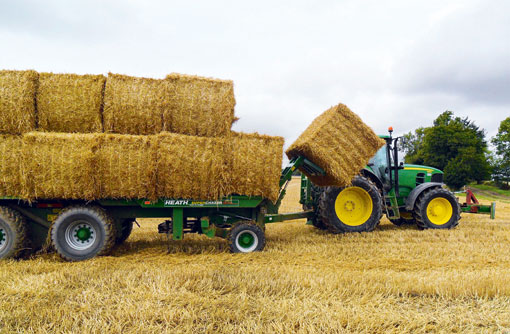
If you want to clear bales from a field fast, the answer is increasingly likely to be a bale chaser, as Peter Hill explains.
The equipment isn’t cheap – £60,000 to £80,000 – but contractors who invest in a bale chaser get a system of collecting and clearing bales that is fast, involves just one man and a tractor, and efficiently stockpiles bales for merchants or industrial uses.
For the farmer on whose land these contractors operate, the bale chaser’s work rate is an attraction in fields where bales need to be cleared so that stubbles can get an early post-combine cultivation. Running in line with the baler and the lack of a separate loading vehicle is also attractive in minimising the wheelings.
The three bale chaser designs available to contractors and large farms each take a different approach to getting bales on to the transport platform – the main challenge being to turn the bales through 90° at some point. A common factor is that bales are picked up on the move, which contributes to their fast work rates.
Heath Superchaser
The Heath Superchaser – a Farmers Weekly farm inventions award winner in its original form – has arguably the simplest approach. A substantial “bumper” on the front of the tractor pushes the bale at one end until it lies across the front of the offset chaser.
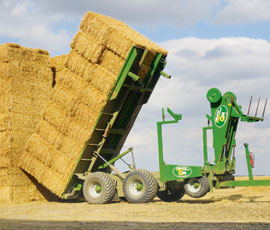 “It requires a bit of skill on the part of the operator, but is something that’s pretty easy to master,” says David Johnson of Big Bale Company North. “With the bale approached sideways on, all we then need is a two-tined fork to lift it off the ground and flip it over and back on to the loading platform.
“It requires a bit of skill on the part of the operator, but is something that’s pretty easy to master,” says David Johnson of Big Bale Company North. “With the bale approached sideways on, all we then need is a two-tined fork to lift it off the ground and flip it over and back on to the loading platform.
“Once two or three bales are in position, the platform pivots upwards to put the bales in an upright stack and push bales already on board further back along the trailer,” he adds. “Each stage is triggered by control buttons on a joystick – we’ve looked at automating the sequence but concluded it’s better to stick with manual control for reliability.”
Transtacker
The Transtacker is derived from the Walton bale chaser design, which underwent a collaborative development programme before all rights were acquired by Big Bale Company South a couple of years ago.
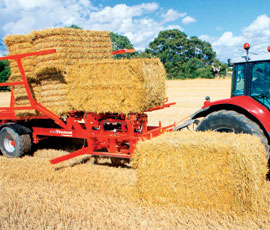
On this machine, bales remain where they were dropped – either flat on their strings or tipped on to one side using a quarter-turn deflector supplied with the machine. Either way, the subsequent loading sequence is operated using a joystick.
“We now have access to very high quality electronic and hydraulic components with an aerospace pedigree at acceptable prices,” says the company’s Paul Bowles. “They have enabled us to simplify the control process without compromising reliability.”
First, bales engaged by the loading mechanism are grabbed on one side by a pair of forks that lift them on to the loading platform in the same alignment.
Once two or three bales are in place, the platform pivots upwards to place the bales in an upright stack, while at the same time moving previously loaded bales down the bed.
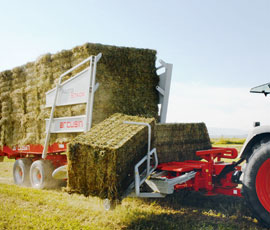 The Transtacker has an additional trick, though, in that a turntable on the platform can be used to rotate the bales through 90° and so build a stack with one or more tying-in layers to improve its stability.
The Transtacker has an additional trick, though, in that a turntable on the platform can be used to rotate the bales through 90° and so build a stack with one or more tying-in layers to improve its stability.
“In practice, you may need to tie in only the first stack of a stockpile,” says Mr Bowles. “The rest could be put together without tying-in, which the telehandler operator will prefer when he comes to dismantle the stacks.”
Arcusin AutoStack
One attraction of the Arcusin AutoStack is that bales are not dragged along the ground for any distance during loading. Instead, they are lifted off the stubble by a short tooth chain conveyor.
“The chains don’t pull the bale aboard, you keep travelling forward at 3-4mph,” points out distributor Stephen Gilman. “Photo cells trigger the hydraulic drive, so the chains are not running all the time as on the previous machine; they start and stop as necessary, which reduces wear.”
Once aboard, the platform rotates through 90°, and the chain drive is activated once more to send the bale on to the top end of the platform, where a pusher mechanism slides the bale to the bottom or up against a previous bale. The platform then lifts the bales upright ready to form a layer of the completed stack.
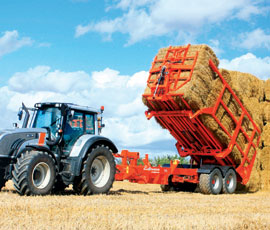
“One thing some people like, is the way the bales finish bottom side up in the stack,” notes Mr Gilman. “The flattened straw makes a bit of a thatch that encourages rain water to run off.”
Clamping and unloading
On all three machines, stack clamping for transport and the unloading sequence are pretty much the same, although there are differences.
The Heath designs, for example, have fixed rear support forks (in addition to side clamps) that slide out from beneath the stack as the transporter is drawn forward, whereas on the Arcusin AutoStack, these forks are withdrawn hydraulically once the stack is upright, but before it is lowered to the ground.
The Transtacker relies on side clamping pressure alone – and in concert with the tying-in feature this is sufficient for the machine to recover stacks and move them elsewhere.
“That means a contractor can quickly clear a field to a headland to allow post-harvest operations to get under way, and then move the stacks to the stockpile area on another day,” says Paul Bowles.
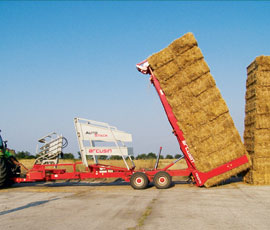 The next challenge to bale chaser manufacturers will likely be to find a way to further reduce wheelings – at present they must run offset so they create their own set of tracks. Generous tyres minimise their impact but advocates of controlled traffic farming would prefer them to run in the baler’s wheelings.
The next challenge to bale chaser manufacturers will likely be to find a way to further reduce wheelings – at present they must run offset so they create their own set of tracks. Generous tyres minimise their impact but advocates of controlled traffic farming would prefer them to run in the baler’s wheelings.
A self-propelled chaser version with a central picking-up mechanism might be one option. But for Paul Bowles of Big Bale Company South, the more likely solution would be to drop bales away from the centreline more accurately.
“We’re already part way there using the quarter-turn deflector, because that moves the biggest bales 1.2m sideways,” he points out. “We’re going to look at ways of doing that more accurately and with different size bales.

